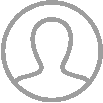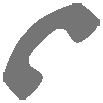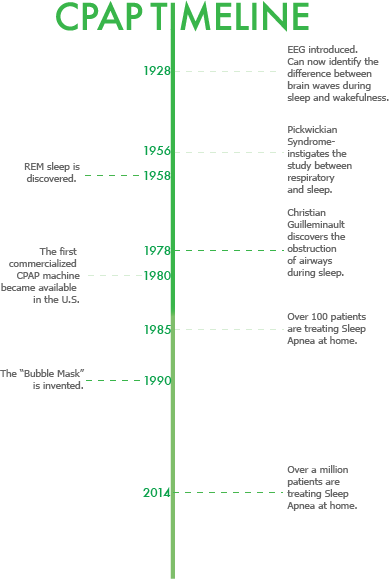Technology has brought humanity to many new frontiers in 2013. A bionic eye. Scalpel-free brain surgery. And advancements enabling donor lungs to continue breathing outside the body so they can be repaired before transplant. Have you ever wondered about the history of CPAP therapy and when the first breakthrough occurred?
Dr. Collin Sullivan, the Inventor of CPAP Therapy
The 1950’s marked the advent of sleep studies, a time when data was recorded with pen and ink. Shortages of paper hindered accuracy and the operator recording the study had to give his/her full attention. In an interview conducted by the National Sleep Foundation, the inventory of CPAP therapy, Dr. Colin Sullivan, sat down to recall the time positive air pressure was introduced and how it ended up revolutionizing the way many sleep.
Back in 1980, Dr. Colin Sullivan first tested the idea of positive pressure applied through the nasal airway in order to alleviate obstructed passageways. It wasn’t until the perfect patient came to his respiratory lab in Australia showing severe signs of Sleep Apnea where this idea became the start of something great. Initially, he recommended a tracheotomy seeing that the obstruction was fairly severe, but the family refused the surgery. Instead, they opted to volunteer for the pressure experiment Dr. Sullivan had been researching for most of his career. Up until this point, dogs had been his only subject.
“I often ask my patients to think of CPAP like reading glasses. They are a nuisance but you can’t do without them. Unlike other therapies, they don’t have to worry about drug side effects.” -Colin Sullivan, M.B.B.S., Ph.D, FRAC
Dr. Sullivan prepared all the materials needed for the patient: plastic tubes and a silicone sealant to move air through the nasal passages. He continued to test by increasing and decreasing the pressure, but it was clear this method worked. After 7 hours of using positive pressure, the patient woke up alert for the first time in years. He knew this was just the beginning for CPAP Therapy.
This was just the first of many experiments that transpired throughout the 80s. Not only did this research jump-start further advances in CPAP therapy, but it also created a platform for researchers to unravel the mysteries behind the numerous medical problems Sleep Apnea causes.
By 1985, Philips Respironics debuted the first suitable system in the U.S. And a few years later in 1990 came the first self-sealing interface, “the bubble mask” which took comfort and therapy to the next level. Although continuous positive airway pressure (CPAP) therapy is now the most common treatment for Sleep Apnea, it was initially created as a short-term option to surgery. It’s interesting to think how one man’s idea has now influenced over a million users today and created a new life expectancy.
A Timeline of the History of CPAP Therapy
The beginning of CPAP Therapy meant more than just great sleep, it brought better health for people all around. With all the information that is available today, and how far Sleep Apnea has come, it’s exciting to think about what could happen in the decades up ahead. Maybe machines and masks will be one entity, or maybe CPAP machines could be as small as a microchip one day. Check out the timeline above to see how the history of CPAP therapy has evolved over time.





27 Responses
I have just taken the 2 night sleep study and will see Doctor Thursday to get results. The 2nd nite, I slept with mask the 1st time. I found it interesting that I sleep so well that evening with full face mask on. When I 1st woke up from sleeping 1st time with full face mask on, I woke up refreshed.
I still feel a little better. Just amazing. I will get results This week from Doctor and hope to find a mask that fits well and get this started. I look at this with enthusiasm.
I am brand new and am open to any advice one would give to a beginner.
Respectfully,
Alex
Alex,
That’s great news! One of the biggest parts of adjusting to CPAP therapy is finding a mask. Sounds like you will be able to jump right in. Here are a few resources that might be helpful in addition to this blog:
1. CPAPtalk.com, which we also host. Our new user section might be especially helpful:
http://www.cpaptalk.com/new-cpap-user.php
2. For product related issues, our Customer Service Team is really great, too. Feel free to give them a call if you have any trouble – 1.800.356.5221.
Hope that helps!
Can you please tell me more about how sleep apnea can be casued by a brain injury? I think I have sleep apnea. Going this weekend for a sleep study to confirm. I feel like I never had this issue until after a major sledding accident (7years ago) in which I am pretty sure I got a concussion.
Wonder how many who utilize CPAP therapy still take naps in the afternoon as their eyelids get heavy? Supposedly they feel “alert” after a full nights rest using this therapy. Most of the folks I know still take naps who use the machine. Seems like a way to spread the wealth further around[milking consumers under a questionable pretense]-someone is always reinventing the wheel to their increase their worth. Ancestors of mine lived long lives without this relatively new concept. Any comment sir or madam?
@Hassan
Sorry for the delay in response! How did your sleep study go? Off the bat I didn’t know too many correlations between Sleep Apnea and brain trauma. But, you got me thinking so I started to do a little bit of research and noticed many who have previously suffered from a TBI have trouble sleeping in general. In fact, researchers believe that 30% to 70% of TBI patients experience a sleep-wake disturbance in some form or fashion.
The thing is, TBI patients’ sleep disorders can be easily misdiagnosed since several symptoms of sleep disturbances are similar to ones you might experience after a TBI. Because it looks as if the brain injury is responsible for the symptoms, they can end up without specific treatment.
Hope all is well!
@Ken Dunlap
You’re right! Our ancestors lived good lives and didn’t need a CPAP. But, they might have suffered from some ailments that could have been treated or reduced if they had a CPAP machine available.
The misconception about CPAP therapy is that, if you have the equipment you will in turn be treated. Just like all of us come in different shapes and sizes, so does CPAP equipment.
After being diagnosed with Sleep Apnea there should be better assistance in getting people the machine and mask they need. But, there is a gap in that process for the majority. This lack of assistance leads people to either, fend for themselves or head to a local durable medical equipment company where options are limited.
For instance if someone sets you up with the wrong mask, chances are you will not get the treatment needed. EVEN IF you sleep with it through the night you will wake up unrested. Don’t underestimate air leaks – the more air that leaks, the more sleep you lose.
See Ken, there are many factors that go into CPAP Therapy. I can’t sit here and tell you it’s easy to start, but I have heard and witnessed many who have found success with their set up. So in the end, it’s worth it.
I just picked up my CPAP machine today and I am very excited by the promise of great sleep. I had great sleep in my study with the mask so I am very optimistic. Thank you for providing the history of CPAP. I was very curious how CPAP came to be. It is very surprising how many people have this issue and are treated with a CPAP machine.
Thank you for a well written history and timeline. In a few weeks I’d be happy to update my experience with CPAP. If you are a person who thinks you may have sleep apnea or other disorder I encourage you to participate in a sleep study.
@Glen Sallee Congrats on your new machine! How’s it coming along? Feel free to reach out if you have any questions!
I believe I was one of the first users of the CPAP system circa 1986 at Research Medical Center, KC, MO. It was a first generation machine. I was told I could only be on it for six months and then they hoped they would have an alternative that I could have. That was 29 years ago. I have lived through every stage since. The first one had a pulley drive and when the belt came off I would have to take it apart and put it back on. The pressure regulator was on the actual mask. It had a black bladder in the line like you see on old pilot movies where the pilot has his oxygen mask on while flying. It never inflated and when it got ripped I just did away with it. The machines have come a long way. I never sleep without mine.
@Paul Myers
Thanks for sharing your first hand experience. You’re right, CPAP therapy has come a long way – portability – ease of use- and visual design.
Wonderful blog. Keep up the good work. There are about 1 million patients being treated for obstructive sleep apnea and there must be countless millions out there who could benefit from this information, not only to gain better sleep, but to have healthier hearts and brains.
Congratulations!
I will be fitted with my first cpap unit in about a week or so,hope to have my sleep apnea issue under control with restful nights and alert days.Hoping for the best.Thanks.
I was diagnosed with sleep apnea about 2 years ago. I have had some success with my machine. Although I am having a slight issue with it. The mask I currently use is small and triangular shape and fits over the nose. From time to time I find that I am awakened during the night due to my mouth falling open during my sleep. Talked with my doctor and my respiratory therapist about this and they suggested a chin strap. I don’t find this is helping. Would there be any other suggestions?
Dr Jen Tien Wung of Columbia University Invented Bubble CPAP in 1970’s. You have to acknowledge him.
I have been wearing a CPAP for 20 years. I wear a full face mask, as I am a mouth breather and cannot wear one just over the nose. I take naps when I want/need to. I am also on disability, but now have a part time job. I did not like the chin strap. I did not like being “tied up” I guess. I changed sleep apnea doctors, and the next one gave me what I needed, instead of trying to make a mouth breather of 40+ years breathe through her nose. It does not work that way. I am in no way yet getting restful sleep. I recently have been given a new CPAP, the Trilogy 100. I am hoping this helps a lot better.
Have you ever heard of a link or cause between OSA and Bells Palsy THank you
@Michael Roberts,
Personally, its not a common link which I’m aware of. However, to think practically about this – since there are three types of Sleep Apnea: Obstructive Sleep Apnea, Central Sleep Apnea, and Mixed. I wouldn’t be surprised if there’s been a cross over of disorders more specifically to those who experience CSA and Mixed Sleep Apnea. I would recommend speaking with your GP for a more thorough explanation on the correlation between the two.
I just started CPAP therapy and didn’t know that an Aussie invented it. The there has made a big difference in how I feel in the mornings. I’might more alert during the day, and I don’t snore at night. All haiI’ll Dr. Sullivan! He should get the Nobel prize for this.
Don’t let them start you with a nose mask. It’s ludicrous and uncomfortable. Start with a full face mask, then check other options if you don’t like it. I gave up on it for a few years when they first tried me with a nose mask; it ticked me off and I thought the whole thing was entirely unreasonable. So I didn’t bother trying anything else. It got so bad I knew I had no choice and went back to it, this time using a nose pillow system. That was tolerable, but presented problems which were only solved with a full face mask. Try different sizes and different makes until you find your right one. You cannot give up on this; CPAP changes your life for the better.
Judging by the references I’ve seen to “mouth leak”, it seems like a lot of people who are mouth breathers are given nose masks and pillows. That’s CRAZY. Get a nasal pillow and a chin strap to keep your mouth closed? WHY? A full face mask is much more comfortable, and i NEVER have leakage problems with mine.
Hi William, I agree with you that a full face mask would be more comfortable for me. However, some CPAP users may feel claustrophobic when using a full face mask, or maybe they just prefer the nose pillows, or a nasal mask.
Because each person is different there are multiple options made available so that everyone can find comfort during their CPAP Therapy.
Thank you very much for your feedback and we wish you continued success with your full face mask!
I got my CPAP machine, the DreamStation, a few weeks ago. I have severe central sleep apnea, maybe from concussions, that has taken years to diagnose. Before the CPAP, I was struggling to stay out of bed. Chronic, horrible, debilitating fatigue day after week after month after year, worse and worse.
I got very emotional reading this history. I am now sleeping, and joking to my friends that all I have to do is sleep to get well. I can not now imagine sleeping without the CPAP. I’m out of bed, better day by day, but it’s going to take time.
If you’re reading this and feeling tired all the time, don’t prolong it. If all I can do is convince one person how valuable CPAP therapy is, may it be you. Tell your doctor you need a sleep study.
Do you happen to know when cpap machines were aproved by the FDA approved by medicare /insurance for common issue for homw treatment. I am atempting to file a claim for apnea with the VA, but i have a gap in timeline between diagnosis and upp surgery in the summer of1990, and 1995 when i got my first cpap. My doctor retired and records are not available anymore.
Hi Kevin,
We are more than happy to help out with this information. Please call our customer support at 1-800-356-5221 for live assistance.
Michael
I’ve been on a CPAP for over 2 years now. Aside from better sleep I’ve experienced a number of other positive benefits. They include more energy, total elimination of acid reflux, reduction in blood pressure meds, uninterrupted nightly sleep almost all of the time without getting up to pee, reduction in edema in feet. My wife loves it because the CPAP emits only a quiet white noise sound which is far quieter than the snoring and snorting noises I made pre-CPAP. I’ve also heard that there may be a relationship between Alzheimer’s and untreated sleep apnea which is a powerful reason to get a CPAP.
I’ve been using a CPAP machine for 25 years. Have there been any studies on the long term use? Are you aware of any side affects of long term use e.g. affects on lungs, throat, etc?